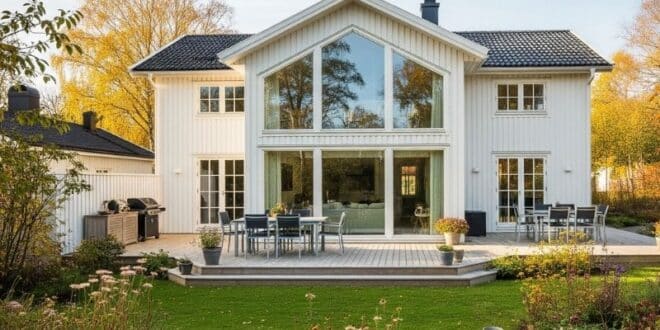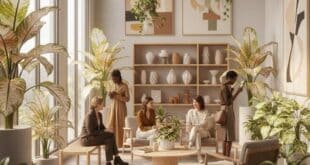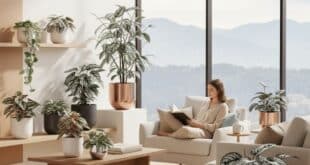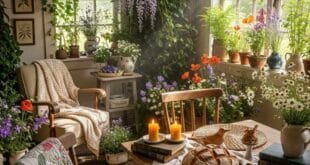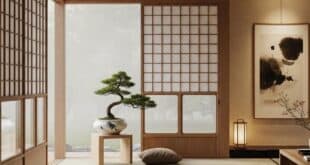Scandinavian Design and Plants
Scandinavian design is a masterclass in serene simplicity. Rooted in functionality, clean lines, and a deep connection to nature, it’s an aesthetic that values light, space, and uncluttered living. Central to this philosophy is the Danish concept of “hygge” (pronounced ‘hoo-ga’)—a feeling of cozy contentment and well-being. And nothing brings life, warmth, and a sense of hygge to a Scandi home quite like the thoughtful placement of plants.
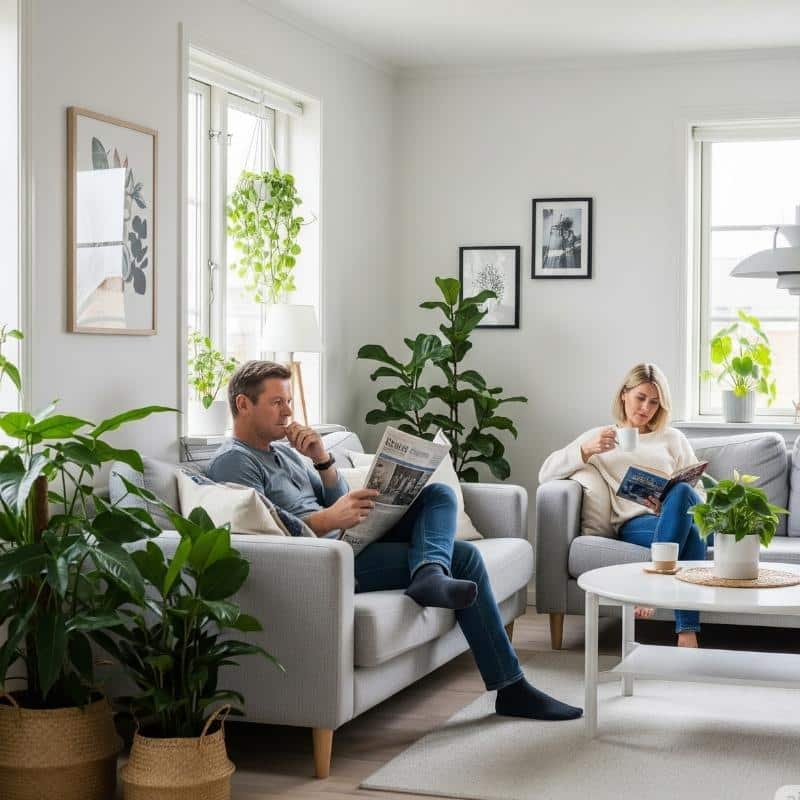
In Scandinavian design, plants are central elements, bringing life and vibrancy to the space while complementing the clean, minimalist aesthetic. They serve as a bridge to the outdoors, especially during long, dark winters. They add a touch of organic softness to minimalist furniture and clean architecture without creating clutter. The key is choosing plants that share the same ethos: simple, elegant, and appreciative of natural light.
Here is a curated list of 15 beautiful, light-loving plants that will help you cultivate a sense of calm and serenity in your Scandi-style sanctuary.
The Foundations of Scandi Greenery
Snake Plant (Sansevieria trifasciata) – The Functional Form
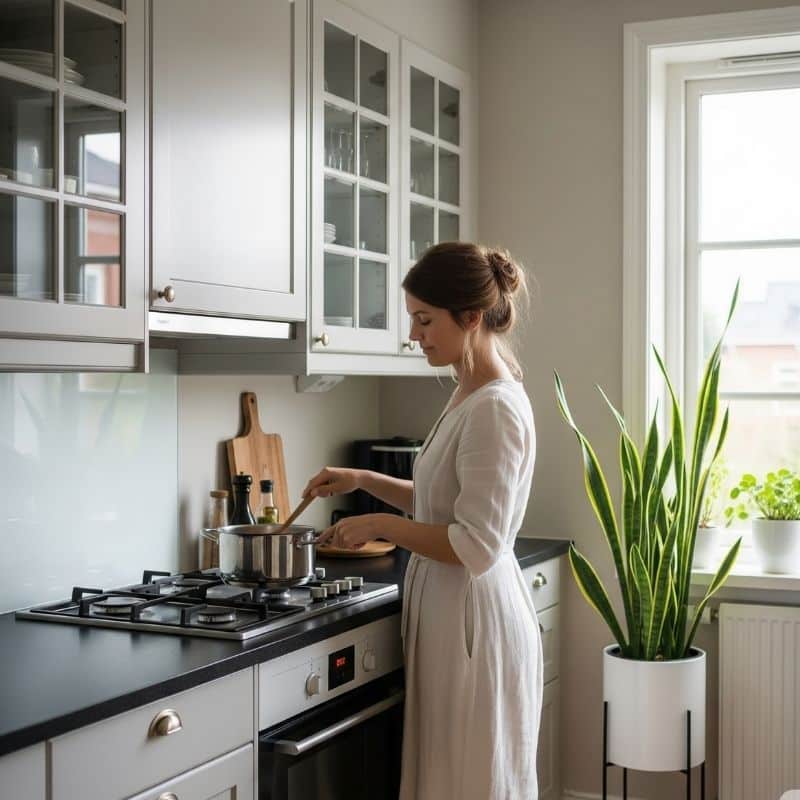
The Snake Plant’s presence in nearly every Scandi-inspired interior is no accident. It is perhaps the perfect physical representation of the Scandinavian principle of funktionalitet (functionalism). Because this plant’s needs are extraordinarily minimal, it aligns perfectly with the desire for an uncluttered life, both physically and mentally. Its strong vertical growth serves an architectural purpose by adding height and structure to a room without taking up valuable floor space. Therefore, it is not just a plant, but a highly efficient, air-purifying, beautiful object that performs its duty with quiet stoicism.
- Light & Location: It tolerates low light but thrives in the bright, indirect light near a north or east-facing window, where its patterns become more pronounced.
- Styling & Materials: Pairs perfectly with the raw, honest texture of a concrete or ceramic pot. Avoid ornate or glossy planters to let the plant’s natural form take center stage.
- The “Hygge” Factor: Its ‘set it and forget it’ nature brings peace of mind. Knowing you have a beautiful living element that isn’t a constant source of worry contributes to a calm and serene home environment.
Pilea Peperomioides (Chinese Money Plant) – The Social Icon
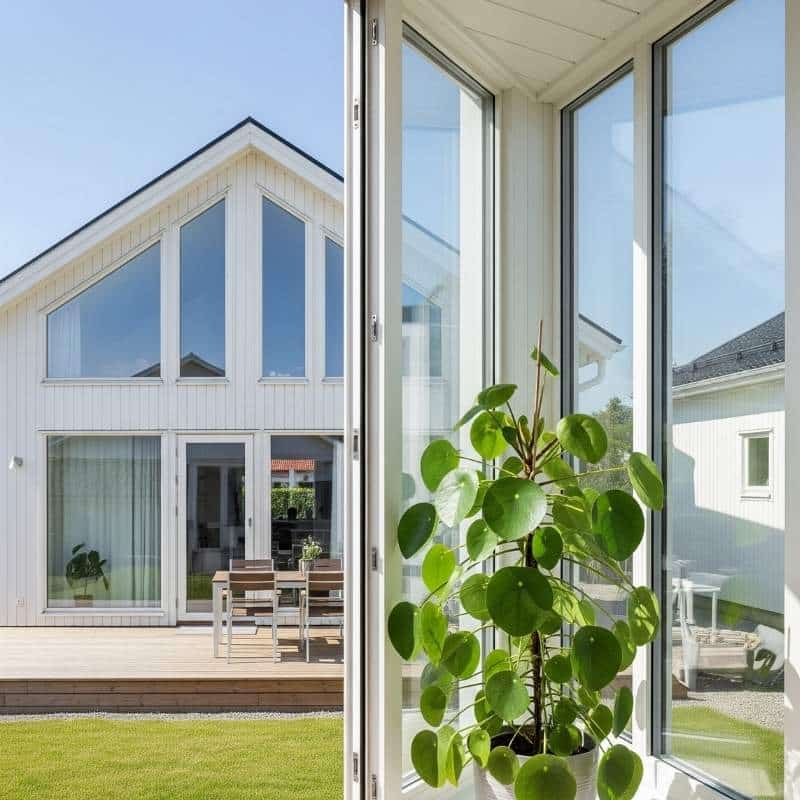
The Pilea’s immense popularity in Scandinavian countries stems from its cheerful, social, and light-loving nature. Its design is inherently optimistic. Because its round, coin-like leaves on delicate, outward-reaching stems create a sense of openness and airiness, they prevent any feeling of visual clutter. More importantly, its tendency to produce ‘pups’ easily makes it a ‘friendship plant.’ The act of propagating and sharing these pups with friends and family is a direct expression of hygge—creating warmth, community, and shared joy.
- Light & Location: Loves bright, indirect light that isn’t scorching. Avoid direct midday sun.
- Styling & Materials: A simple, white ceramic pot or a raw terracotta pot showcases its playful form perfectly.
- The “Hygge” Factor: Nurturing the growth of a Bird of Paradise and propagating its offshoots is a rewarding practice, fostering mindfulness and gratitude for nature’s beauty and abundance.
ZZ Plant (Zamioculcas zamiifolia) – The Effortless Elegance
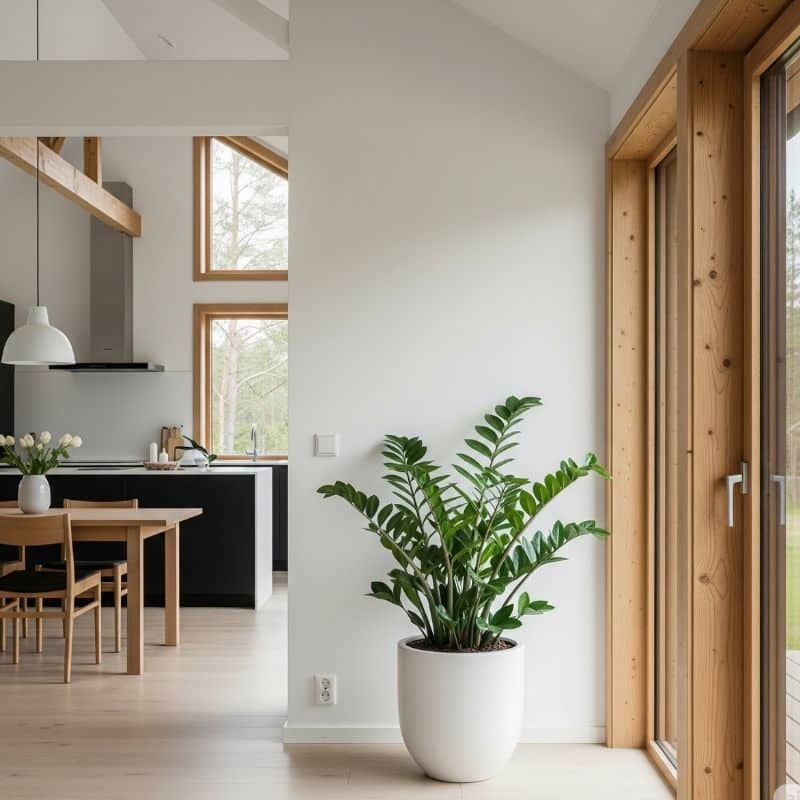
The ZZ Plant, with its deep green, glossy leaves, embodies quiet confidence. It stands as a testament to the beauty of simplicity and resilience. Because its structure is self-contained, tidy, and slow-growing, it brings a sense of predictable, calm order to a space. This is especially important for a lifestyle that values “lagom” (just the right amount) and avoids excess. It’s a reliable friend that adds beauty without causing concern.
- Light & Location: It’s extremely tolerant of low light, making it a practical and functional choice for less sunny rooms in Nordic homes.
- Styling & Materials: A matte black or deep grey geometric pot creates a striking contrast with its glossy leaves.
- The “Hygge” Factor: Its near-indestructible nature removes any “plant care anxiety,” allowing your home to be a true sanctuary for rest and enjoyment.
Fiddle Leaf Fig (Ficus lyrata) – The Natural Statement
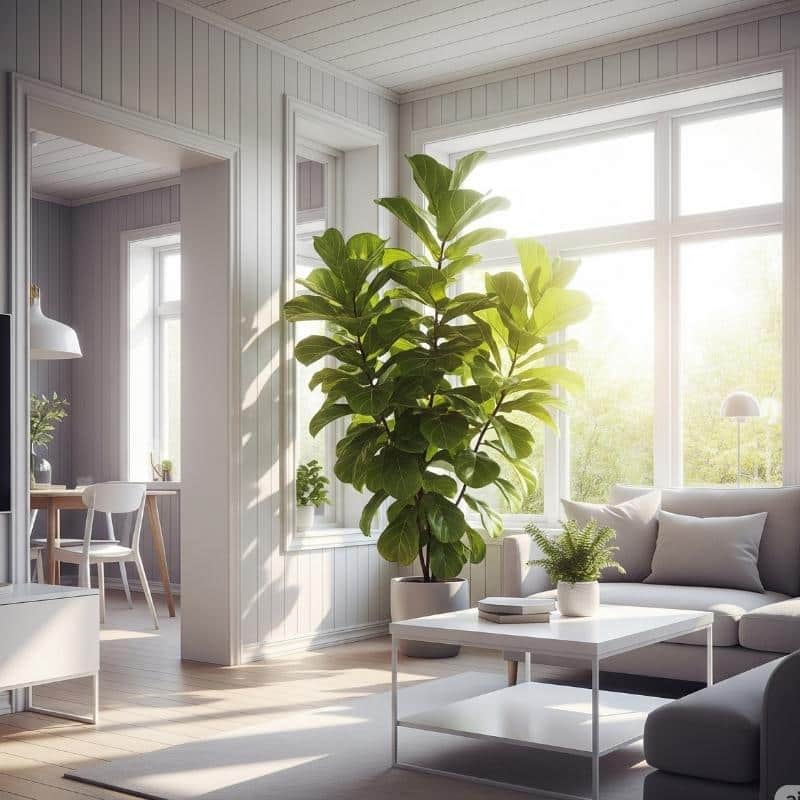
A Fiddle Leaf Fig is more than a plant; it’s a piece of living architecture. In Scandinavian design, large, empty walls are often used intentionally as “negative space.” Because of the Fiddle Leaf Fig’s grand scale, it can fill these spaces with a single, bold gesture, providing a focal point and a sense of “life” to the room. This single act eliminates the need for many smaller, clutter-inducing decorative items, perfectly adhering to the “less is more” principle.
- Light & Location: It craves a consistent spot with plenty of bright, indirect light. It does not like to be moved around.
- Styling & Materials: A woven basket made of natural jute or seagrass is the perfect pot cover to complement its green leaves with warm texture.
- The “Hygge” Factor: Caring for it requires a mindful routine. This deliberate act of care forges a connection with the rhythms of nature and provides a satisfying sense of responsibility.
Rubber Plant (Ficus elastica) – The Moody Contrast
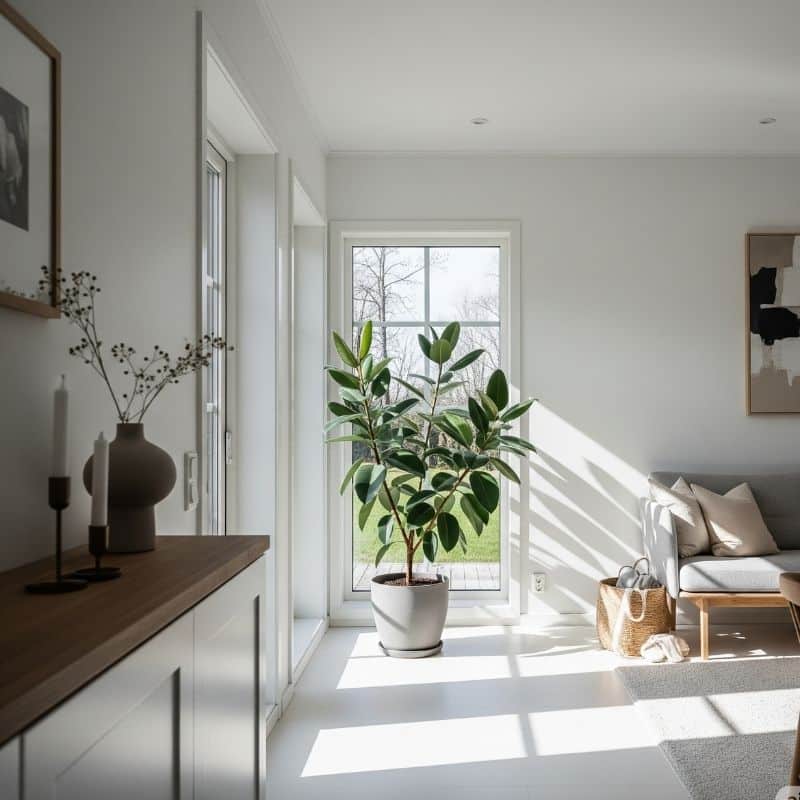
While Scandi style is famous for its light palette, its character comes from thoughtful contrast. The Rubber Plant is a master of this. In a room dominated by light wood floors, white walls, and neutral textiles, the dark, rich, glossy leaves of a Rubber Plant act as a visual anchor. This prevents the space from looking one-dimensional or “flat” and gives it a sense of depth and sophistication. It’s living proof that simplicity doesn’t have to be boring.
- Light & Location: It takes on its best color in bright, indirect light but can tolerate less luminous conditions.
- Styling & Materials: A light grey concrete planter or a simple, tapered white ceramic pot highlights its modern, sculptural presence.
- The “Hygge” Factor: Watching a new leaf slowly unfurl from its reddish sheath is a fascinating process that offers a great opportunity to appreciate nature’s slow and steady power.
Delicate Textures & Trailing Lines
String of Hearts (Ceropegia woodii) – The Dainty Drapery
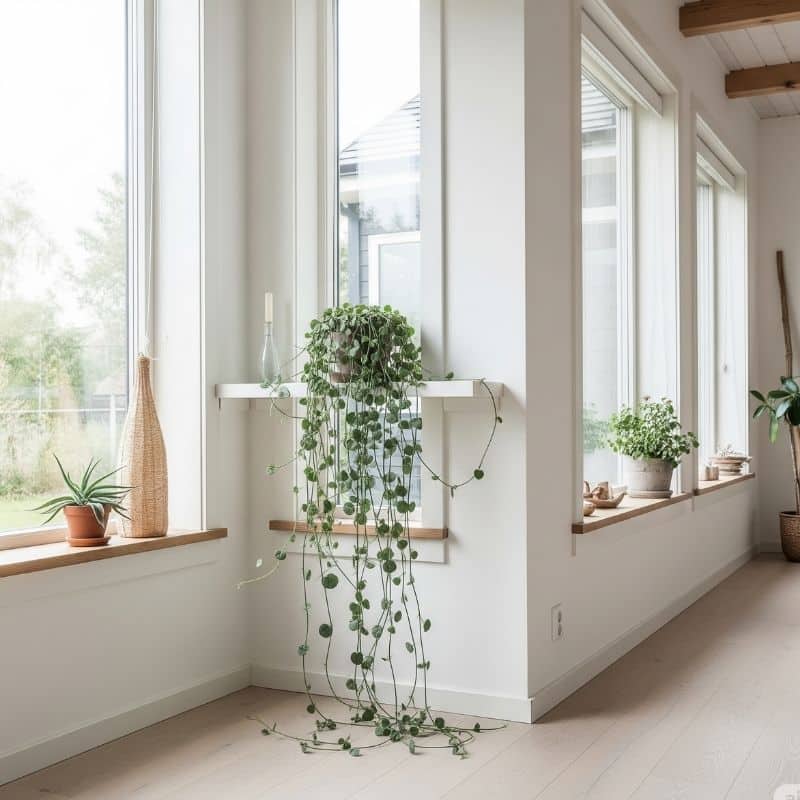
Scandinavian design achieves harmony by seamlessly combining crisp, structured lines with soft, natural textures, creating a balanced and inviting aesthetic. The String of Hearts is the perfect tool for this. Because its almost weightless, thread-like vines and tiny heart-shaped leaves cascade down, they soften the hard, straight line of a window frame or a shelf. This results in a space that feels romantic and cozy, preventing the clean aesthetic from feeling cold or stark.
- Light & Location: It loves bright, indirect light, which helps bring out the silvery patterns on its leaves.
- Styling & Materials: It looks most impressive when allowed to trail from a high shelf or from a minimalist hanging planter made of brass or another warm metal.
- The “Hygge” Factor: Its delicate nature encourages gentle, careful interaction. This slow, mindful act of care can be a calming ritual.
Spider Plant (Chlorophytum comosum) – The Airy Fountain
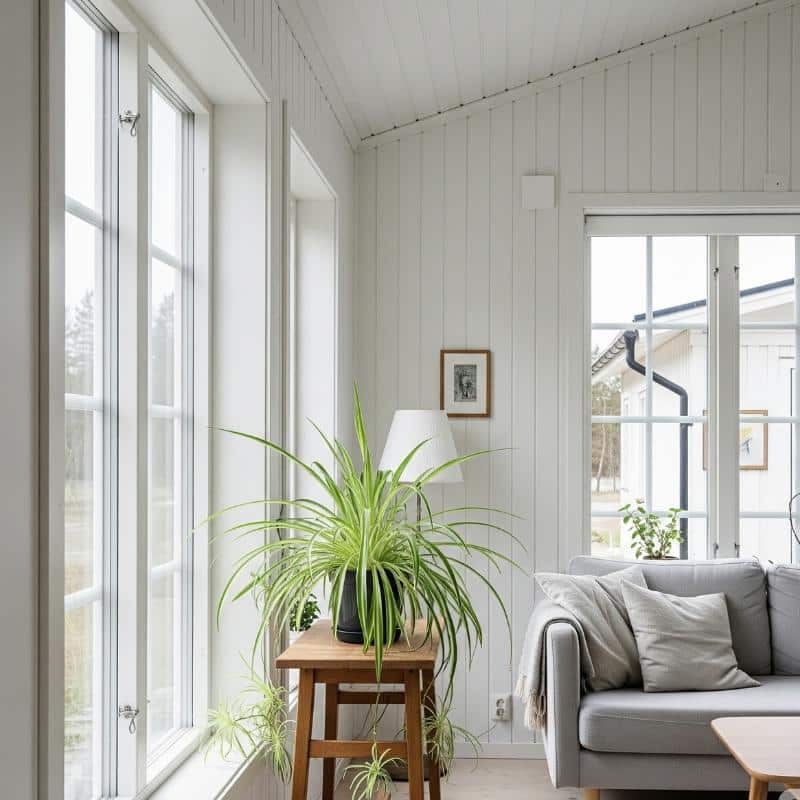
The Spider Plant is a celebration of life and effortless abundance. Its arching leaves create a dynamic shape that seems to explode outwards. Because the Scandi lifestyle values practicality and sustainability, the Spider Plant’s ability to easily produce its own “pups” that grow into new plants aligns perfectly. The idea of creating dozens of new plants from one source mirrors a philosophy of using resources efficiently.
- Light & Location: It adapts to a wide range of light conditions, making it a versatile choice for almost any room.
- Styling & Materials: A simple hanging pot or a place atop a tall cabinet allows its fountain-like form to be fully displayed.
- The “Hygge” Factor: Separating the pups and potting them to give as gifts to friends is a tangible act of creating and sharing happiness.
Asparagus Fern (Asparagus setaceus) – The Feathery Cloud
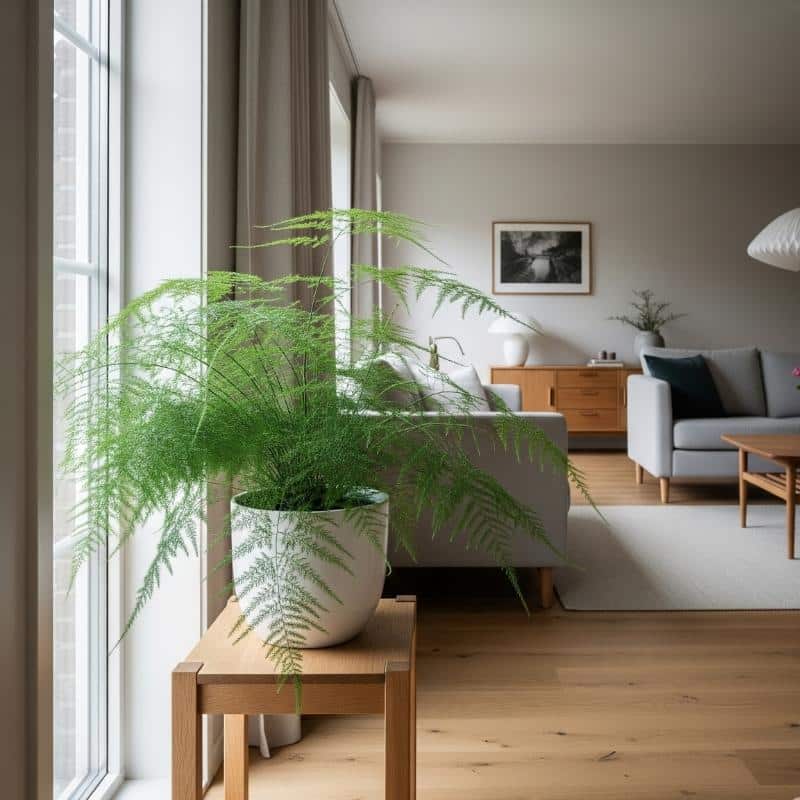
The feeling of “hygge” is deeply connected to tactile comfort—soft blankets, warm wood. Because the Asparagus Fern’s foliage is so fine and feathery, it brings this sense of tactile comfort into the visual realm. It offers a soft, complex texture that serves as the perfect antidote to the hard, clean surfaces common in Scandi design, making the entire room feel warmer and more inviting.
- Light & Location: It loves high humidity and bright, indirect light, making it a perfect candidate for a bathroom or kitchen.
- Styling & Materials: Its complex form is best showcased in a simple, solid-colored pot that doesn’t compete for attention.
- The “Hygge” Factor: Misting it with water is a small, meditative act that reinforces the feeling of caring for your home environment.
Hoya Linearis – The Nordic Waterfall
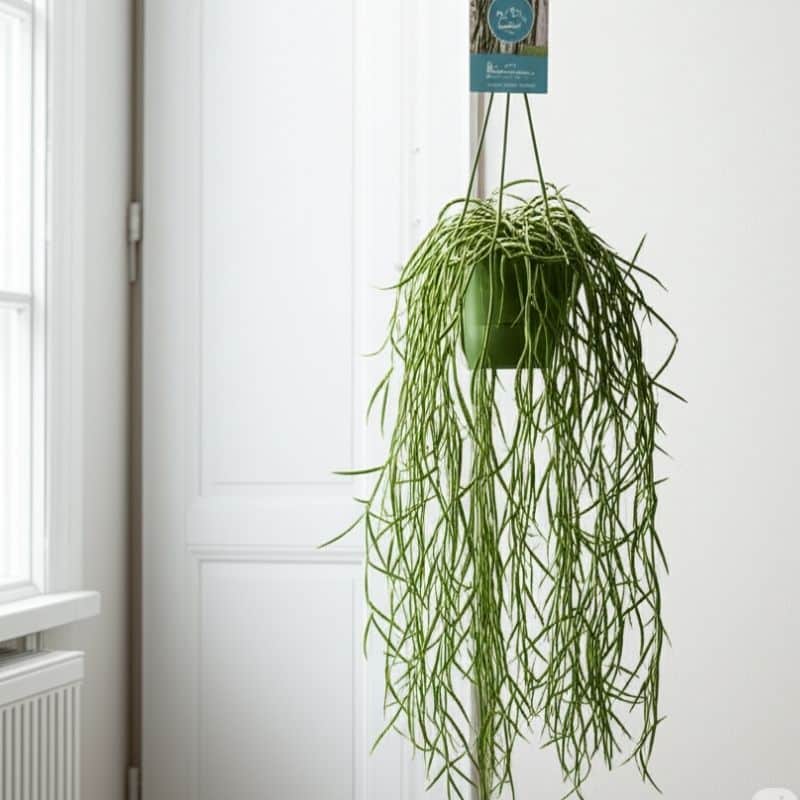
This unique Hoya is a minimalist statement in motion. It doesn’t reach out; it simply falls, creating a serene curtain of green. Because its long, needle-like leaves form perfect vertical lines, it mirrors the simplicity and geometry of Scandinavian design. At the same time, it evokes one of nature’s most calming forms—a waterfall. This is the art of creating a profound impact without any excess ornamentation.
- Light & Location: It enjoys a bright spot, protected from drafts.
- Styling & Materials: It creates the most dramatic effect when hung from a high point, like the top corner of a window or from a ceiling beam.
- The “Hygge” Factor: Its calm, slow growth adds a peaceful and constant element of serenity to the home. Watching it is a calming experience.
Subtle Statements & Functional Flora
Peace Lily (Spathiphyllum) – The Serene Bloom
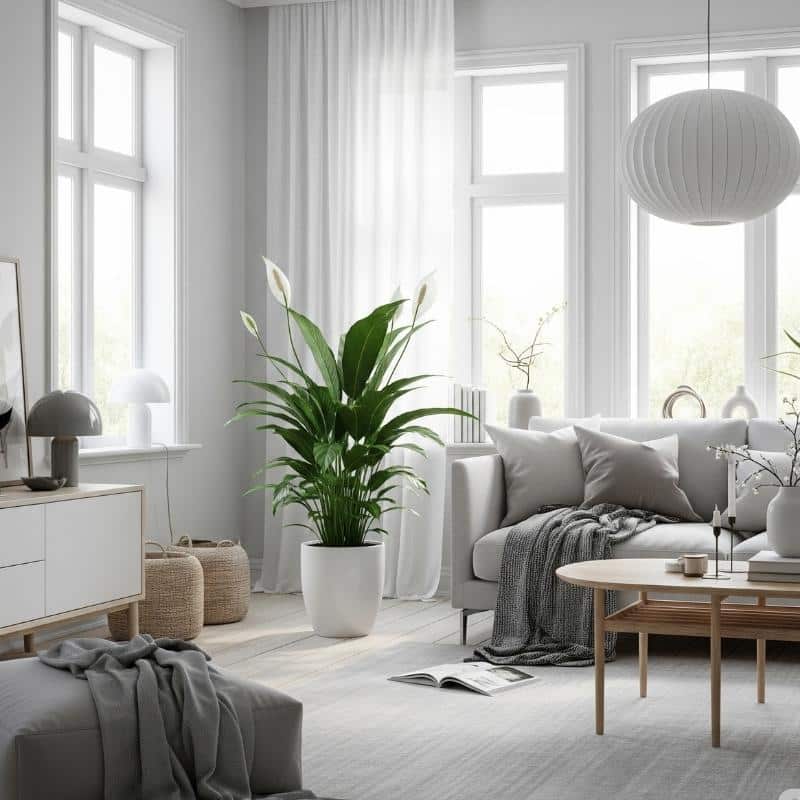
The Peace Lily is valued for its dual role as both a beautiful foliage plant and a producer of elegant white blooms. The Scandi aesthetic values objects that are both beautiful and functional. Because the Peace Lily is known for its air-purifying ability (function) and produces minimalist white flowers (beauty), it perfectly fits this philosophy. It doesn’t just decorate your home; it actively works to create a healthier living space.
- Light & Location: It’s happy in medium to bright indirect light. Direct sun will scorch its leaves.
- Styling & Materials: A simple, glazed ceramic pot beautifully complements its glossy green leaves and white flowers.
- The “Hygge” Factor: The way it droops its leaves slightly to “tell” you it’s thirsty makes its care intuitive and stress-free.
Olive Tree (Olea europaea) – The Rustic Sophisticate
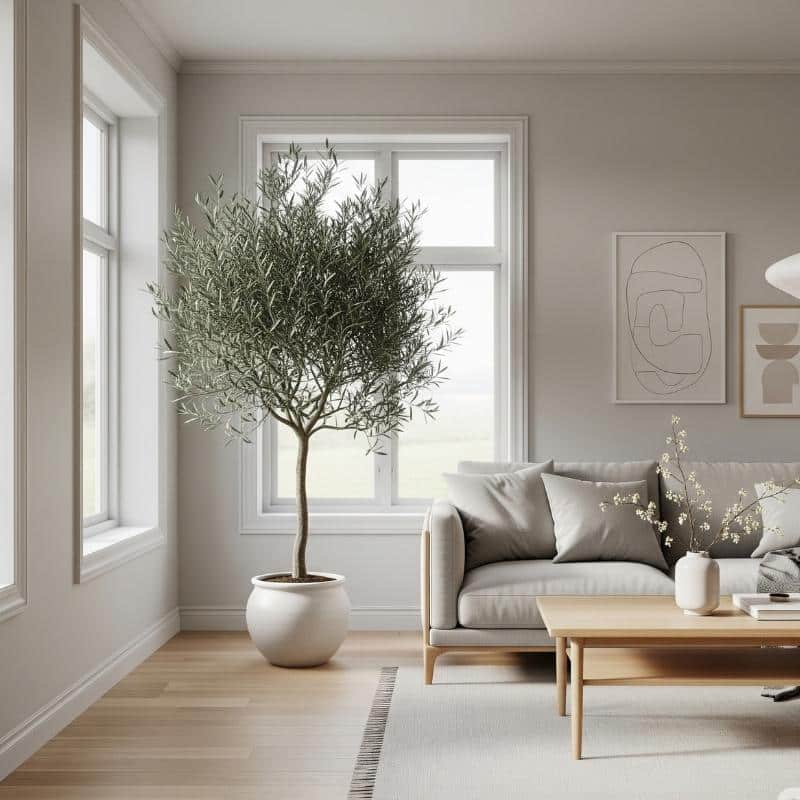
An indoor Olive Tree is like a piece of functional history. Scandinavian design has a deep respect for authentic, natural materials. Because the Olive Tree’s gnarled trunk and silvery leaves have an authentic, weathered character, they add a sense of “realness” and history to a space, distinguishing it from mass-produced items. This reflects an appreciation for skilled craftsmanship and the inherent charm found in natural imperfection.
- Light & Location: It needs sun, and lots of it. A south-facing window is a must for it to thrive indoors.
- Styling & Materials: An unglazed, raw terracotta pot is the best choice to honor its Mediterranean origins.
- The “Hygge” Factor: Bringing a piece of the sunny outdoors inside provides a boost of warmth and morale, especially during long, dark winters.
Orchid (Phalaenopsis) – The Intentional Accent
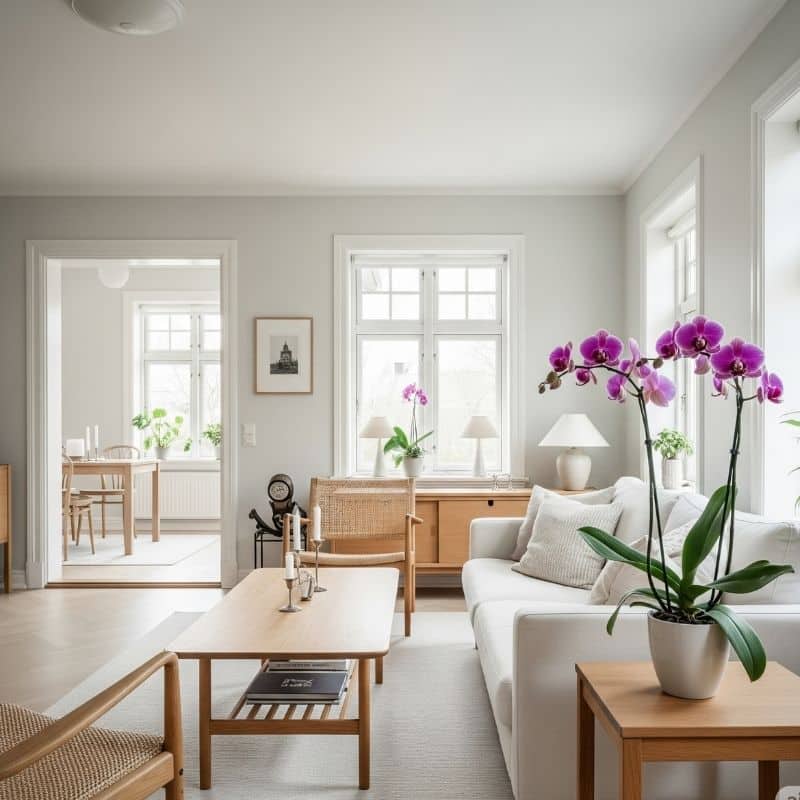
An orchid elegantly embodies the ‘lagom’ philosophy, achieving a balance that is neither excessive nor minimal, but perfectly harmonious and serene. Rather than filling a room with dozens of small, distracting objects, using a single, high-impact, and elegant element like an Orchid creates a sense of minimalist luxury and focused beauty. This is a conscious and selective approach to decoration.
- Light & Location: It loves a bright windowsill but should be shielded from direct, harsh sun.
- Styling & Materials: The clear plastic pot it often comes in is good for its roots. You can place this inside a simple glass or ceramic cachepot.
- The “Hygge” Factor: Getting an Orchid to re-bloom takes patience and care. When it happens, it provides a huge sense of satisfaction and a chance to witness nature’s cycles.
Eucalyptus – The Calming Aroma
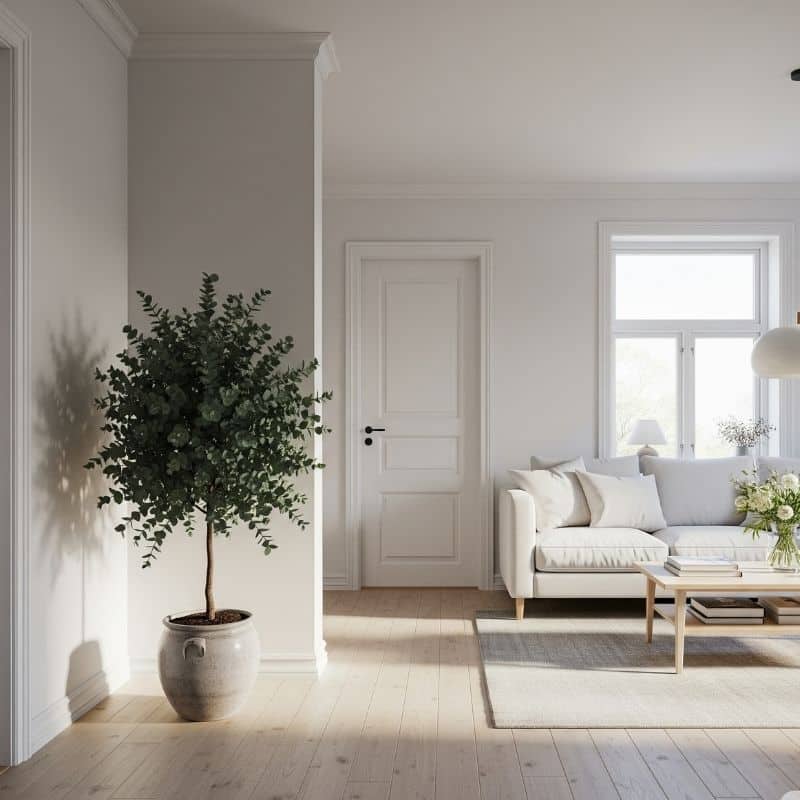
A potted Eucalyptus brings a multi-sensory experience. It is chosen not just for its unique, silvery-blue leaves but for its distinct, calming fragrance. “Hygge” goes beyond a mere visual concept; it is a holistic experience that engages all the senses, creating a warm and comforting atmosphere. Because the fresh, clean scent released by the Eucalyptus leaves fills a room, it instantly creates a spa-like or nature-walk atmosphere, resulting in a calm and purified environment.
- Light & Location: It is a sun-worshipper. Give it the brightest and airiest spot in your home.
- Styling & Materials: A simple white pot or a galvanized metal planter complements its cool color tones beautifully.
- The “Hygge” Factor: Gently rubbing a leaf and inhaling its fresh, natural aroma is a simple yet effective way to reduce stress and promote relaxation.
Calathea White Fusion – The Living Watercolor
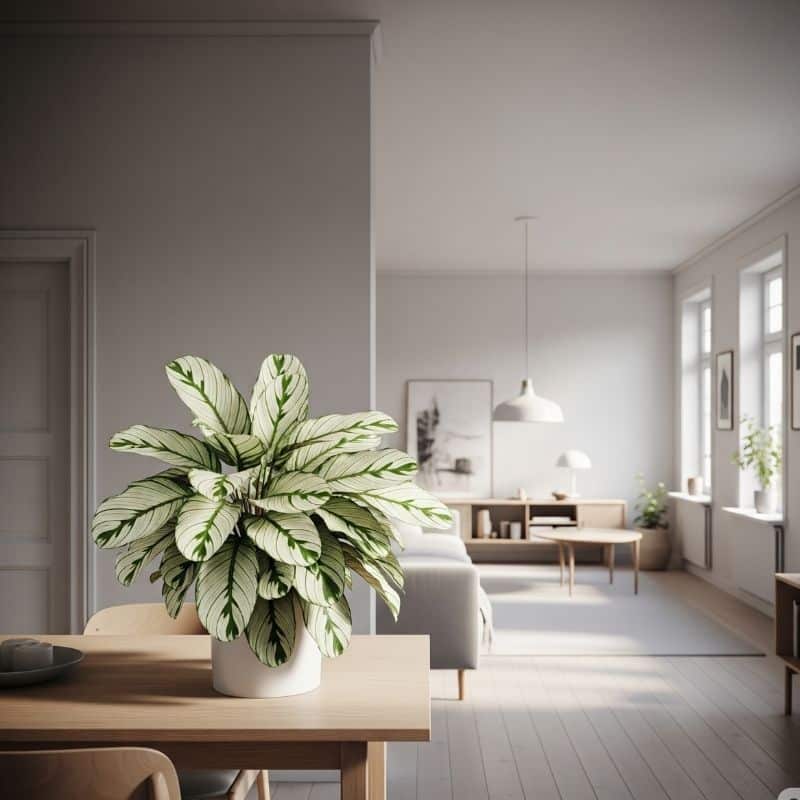
This plant is for the Scandi enthusiast who appreciates intricate detail within a simple framework. It serves as a beautiful reminder that nature is the ultimate creator, inspiring awe and connection with its unparalleled artistry. Because its complex patterns of white, green, and lilac are displayed on a simple leaf structure, it provides the same sophisticated impact as an expensive piece of art when placed against a plain background, but in a much more organic way.
- Light & Location: It requires high humidity and bright, indirect light. Direct sun will scorch its leaves and fade its patterns.
- Styling & Materials: Its complex patterns stand out best in a solid-colored, un-patterned pot.
- The “Hygge” Factor: The way it folds its leaves upwards at night is a gentle reminder that it is “alive” and has its own daily rhythm, adding a dynamic element to your home.
Christmas Cactus (Schlumbergera) – The Seasonal Hygge
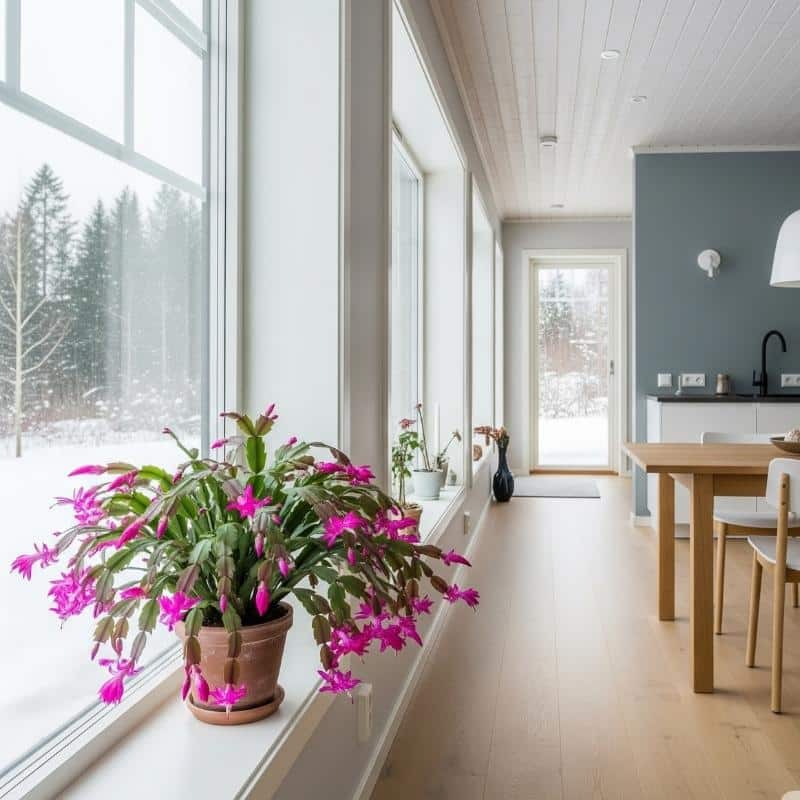
This unassuming succulent spends most of the year as a quiet, green presence, only to burst into a spectacular display of colorful flowers during the darkest time of year. Because this plant blooms in the dead of winter, it perfectly reflects the Scandinavian tradition of celebrating light and creating warmth and cheer when it’s needed most. Its bloom is a symbol of hope and the joy of seasonal festivities.
- Light & Location: It needs bright, indirect light and shorter daylight hours at certain times of the year to trigger blooming.
- Styling & Materials: It looks wonderful in a hanging pot or on the edge of a shelf, where its cascading, segmented stems can hang freely.
- The “Hygge” Factor: The annual anticipation of its blooms can become a joyful family tradition tied to the changing of the seasons.
Cultivating Your Serene Sanctuary
In Scandinavian design, every plant is chosen with thoughtful intention, ensuring it complements the space’s simplicity and natural harmony. The goal isn’t to collect as many as possible, but to select a few that bring you joy, enhance your space, and connect you to the simple beauty of the natural world. By focusing on light, form, and function, you can create a home that is not only stylish but is a true sanctuary of calm and hygge.

